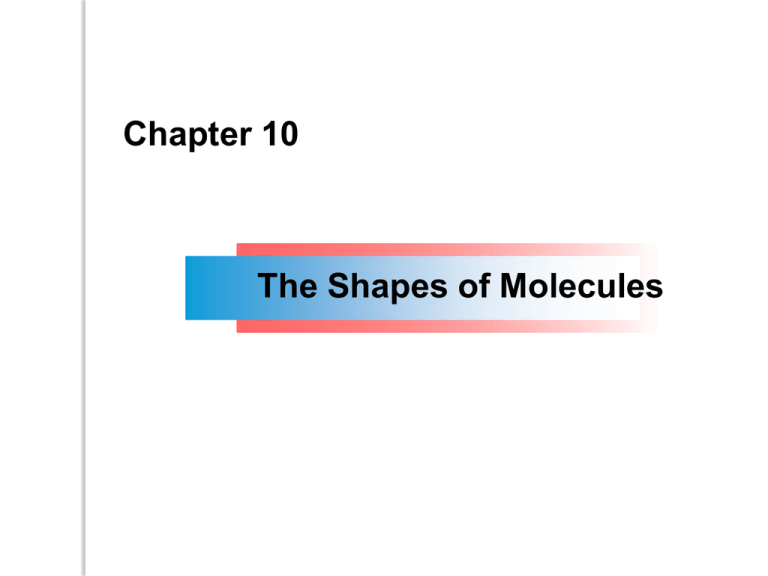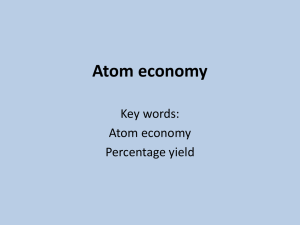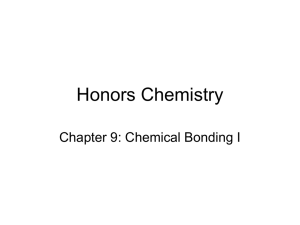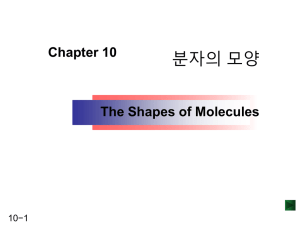silbchp10
advertisement

Chapter 10 The Shapes of Molecules Copyright ©The McGraw-Hill Companies, Inc. Permission required for reproduction or display. Lewis Structures Mostly using the Octet Rule, but there are exceptions The best rules are in your handouts as well as in your lecture notes and following. Use them! 10-2 Copyright ©The McGraw-Hill Companies, Inc. Permission required for reproduction or display. THE BEST RULES for writing Lewis Electron Dot structures for covalent compounds: 1. Write the Lewis structure for each atom, then total the number of valence electrons. DO NOT worry about which electrons go with which atom! For example, CO2 would have a total of 16 valence electrons. 2. Put the atom that is "leftist &/or lowest" as the central atom. Arrange the other atoms around it. Then draw one single covalent bond of 2 electrons from the central atom to each of the other atoms around it. Subtract the number of electrons in bonds from the total found in step 1. In the CO2 example, C is central and O’s are terminal. The electron counting is: 16 - 4 = 12. 3. Put the remaining electrons around the terminal atoms as lone pairs of electrons until they are “happy,” except for H. (Why?) If there are still some electrons left they go on the central atom. 10-3 Copyright ©The McGraw-Hill Companies, Inc. Permission required for reproduction or display. THE BEST RULES for writing Lewis Electron Dot structures for covalent compounds: 4. See if each atom has 8 electrons around it. If not, you take one lone pair on a terminal atom and make it a bond pair, then another, etc., until all the atoms are happy. (This is what makes multiple bonds, double or triple is possible, quadruple is not!) In CO2 our O's are happy but C is not. Take a LP from each terminal O and make it a bond pair. 5. Check again that you have a total of 16 electrons and that all atoms “think” that they have 8 electrons. If it is a polyatomic ion, you must account for the charge by adding in extra electrons in step 1 if it is an anion, or subtracting if it is a cation, like NH4+. The bracket must be placed around the structure and the charge indicated. 10-4 SAMPLE PROBLEM 10.1 Write a Lewis structure for CCl2F2. SOLUTION: Cl C : : : Cl : :Cl C : : F: : Steps 4 & 5: Each atom has 8 e-s, and the total is still 32. F F : Steps 1, 2 & 3: There are 32 total valence e-s. Put C in center & arrange other terminal atoms around it. Each bond is 2 e-s, or 8 e-s. 32-8=24 e-s to go as LP’s. There is room enough for all 24 e’s, so none go on the central atom. Cl Note that bonds can be shown as lines, but lone pairs of electrons are always dots! F: : PROBLEM: Writing Lewis Structures for Molecules with One Central Atom Copyright ©The McGraw-Hill Companies, Inc. Permission required for reproduction or display. More Complex Lewis Structures Many compounds have more than one central atom, especially organic compounds where all the carbon atoms are “central” and all H’s are terminal. With multiple bonds, consider how many single bonds each atom would usually “like” to make: C = 4, O = 2, N = 3, H and F always = 1, halogens “like” 1 H2O2 has two O atoms as central. Draw it that way and distribute the H’s equally around the two central atoms. Keep using the rules! .. .. H-O-O-H .. .. 10-6 SAMPLE PROBLEM 10.2 Writing Lewis Structure for Molecules with More than One Central Atom Hydrogen can have only one bond so C and O must be next to each other with H’s around them. There are 4(1) + 4 + 6 = 14 valence e-s. C likes to have 4 bonds and O likes to have 2, therefore O gets the 2 Lone Pairs of e-s. H : SOLUTION: Write the Lewis structure for methanol (molecular formula CH3OH). H C O : PROBLEM: H H SAMPLE PROBLEM 10.3 PROBLEM: SOLUTION: H (a) There are 2(4) + 4(1) = 12 valence e-. H can have only one bond per atom. C wants to make 4 bonds. : H Writing Lewis Structures for Molecules with Multiple Bonds. Write Lewis structure for Ethene (C2H4), the most important reactant in the manufacture of polymers and also for N2. C C H H H H H C C H Copyright ©The McGraw-Hill Companies, Inc. Permission required for reproduction or display. Diatomic nitrogen N2 has 10 valence e-s N-N 10-2=8 e-s remain .. .. :N-N: 8 – 8 = 0 e-s, but neither N happy Move one LP from each N in to become a shared pair or covalent bond: :N=N: Triple bond makes N happy 10-9 Copyright ©The McGraw-Hill Companies, Inc. Permission required for reproduction or display. Lewis Structures PRACTICE: OF2, H2CO, NO2, O3, I3-, HCOOH, CH3CH2OH, SF4, NO, C6H6 in a ring EXCEPTIONS: H2 has only two e-s each - not an octet. Why is that OK? I3- and SF4 have EXPANDED valence shell central atom has 10 e-s NO has a lone e- called a FREE RADICAL, makes it a very reactive compound 10-10 Copyright ©The McGraw-Hill Companies, Inc. Permission required for reproduction or display. Lewis Structures O3 and C6H6 can be written in two different ways: which is the correct way? BOTH ARE! RESONANCE STRUCTURES: resonance is an OLD concept: e-s don't bounce around bond to bond, but are continually being shared. 10-11 Resonance: Delocalized Electron-Pair Bonding O3 can be drawn in 2 ways - O O O O O O Neither structure is actually correct but can be drawn to represent a structure which is a hybrid of the two - a resonance structure. B B O O O A O C O O O O A O C Resonance structures have the same relative atom placement but a difference in the locations of bonding and nonbonding electron pairs. is used to indicate that resonance occurs. SAMPLE PROBLEM 10.4 Writing Resonance Structures PROBLEM: Write resonance structures for the nitrate ion, NO3-. SOLUTION: Nitrate has 1(5) + 3(6) + 1 = 24 valence e24 – 6 = 18 O 18 – 18 = 0 O O O N N N O O O O O N does not have an octet; a pair of ewill move in to form a double bond. O O O O N N N O O O O O Formal Charge: Selecting the Best Resonance Structure An atom “owns” all of its nonbonding electrons and half of its bonding electrons. Formal charge is the charge an atom would have if the bonding electrons were shared equally. Formal charge of atom = # valence e- - (# unshared electrons + 1/2 # shared electrons) B # valence e- =6 O e- A # nonbonding # bonding For OC O For OA e- =4 = 4 X 1/2 = 2 O C For OB # valence e- = 6 Formal charge = 0 # valence e- = 6 # nonbonding e- = 6 # bonding e- = 2 X 1/2 = 1 Formal charge = -1 # nonbonding e- = 2 # bonding e- = 6 X 1/2 = 3 Formal charge = +1 Resonance (continued) Three criteria for choosing the more important resonance structure: Smaller formal charges (either positive or negative) are preferable to larger charges. Avoid like charges (+ + or - - ) on adjacent atoms. A more negative formal charge should exist on an atom with a larger EN value. Resonance (continued) EXAMPLE: NCO- has 3 possible resonance forms - N C O N C A N O B C O C formal charges -2 N 0 +1 C O -1 0 N C 0 O 0 N 0 C -1 O Forms B and C have negative formal charges on N and O; this makes them more preferred than form A. Form C has a negative charge on O which is the more electronegative element, therefore form C contributes the most to the resonance hybrid. SAMPLE PROBLEM 10.5 Writing Lewis Structures for Octet Rule Exceptions PROBLEM: Write Lewis structures for (a) H3PO4 (pick the most likely structure); (b) BFCl2. SOLUTION: (a) H3PO4 has two resonance forms and formal charges indicate the more important form. -1 0 O 0 H O P O 0 H 0 +1 O H 0 0 0 0 H O 0 O 0 P O H 0 0 O H 0 (b) BFCl2 will have only 1 Lewis structure. B is edeficient! F 0 more stable Lower formal charges (plus O likes to make 2 bonds). P has expanded valence shell. B Cl Cl Copyright ©The McGraw-Hill Companies, Inc. Permission required for reproduction or display. Localized electron bonding model: Assumes that a molecule is composed of atoms that are bound together by sharing pairs of e-s using the atomic orbitals of the bound atoms - shared pairs are called bonding pairs - those found on one atom are called lone pairs This basic model was seen with our drawing of Lewis structures It is also the basis of VSEPR Theory 10-18 Copyright ©The McGraw-Hill Companies, Inc. Permission required for reproduction or display. VSEPR THEORY: VALENCE SHELL ELECTRON PAIR REPULSION THEORY Methane’s Lewis dot structure is 2-D and looks flat with 90o bond angles. Methane in reality, in 3-D, is a regular tetrahedron with bond angles = 109° Are CH3Cl and CH2Cl2 equivalent geometric structures? Molecular Shape = function of repulsion of electron pairs in valence shell of central atom(s) Electron pairs try to arrange themselves as far apart as possible to minimize repulsions - this includes LP's as well as BP's - to minimize electrostatic repulsion. 10-19 Copyright ©The McGraw-Hill Companies, Inc. Permission required for reproduction or display. VSEPR THEORY: VALENCE SHELL ELECTRON PAIR REPULSION THEORY This leads to five major families of e- pair arrangements: linear, trigonal planar, tetrahedral, trigonal bipyramidal, octahedral. When drawing these we use AXbEc where: A= central atom X (or B) = surrounding atom(s) E = nonbonding valence e- group (lone pair) 10-20 Figure 10.2 Electron-group repulsions and the five basic molecular shapes. linear trigonal bipyramidal tetrahedral trigonal planar octahedral Figure 10.3 The single molecular shape of the linear electron-group arrangement. Examples: CS2, HCN, BeF2 Figure 10.4 The two molecular shapes of the trigonal planar electron-group arrangement. Examples: SO2, O3, PbCl2, SnBr2 Examples: SO3, BF3, NO3-, CO32- Figure 10.5 The three molecular shapes of the tetrahedral electrongroup arrangement. Examples: CH4, SiCl4, SO42-, ClO4- NH3 H 2O PF3 OF2 ClO3 SCl2 H 3 O+ Figure 10.7 The four molecular shapes of the trigonal bipyramidal electron-group arrangement. PF5 SF4 AsF5 XeO2F2 SOF4 IF4+ IO2F2- XeF2 ClF3 I3 - BrF3 IF2- Figure 10.8 The three molecular shapes of the octahedral electrongroup arrangement. SF6 IOF5 BrF5 TeF5 - XeOF4 XeF4 ICl4- Copyright ©The McGraw-Hill Companies, Inc. Permission required for reproduction or display. Atomic bond angles: Bond angles are important in determining a compound's chemical behavior If all "ligands" are equal, each structural shape has specific bond angles Bond angles are affected if there's a multiple bond, a variety of ligands, and by lone pairs LP's affect bond angles and the shape of the molecule Stronger electrostatic repulsions: LP-LP > LPBP > BP-BP 10-27 Copyright ©The McGraw-Hill Companies, Inc. Permission required for reproduction or display. “Electron Pair Families - Minor” TRIGONAL PLANAR GROUP: - each has 3 e- pairs around central atom, at corners of a trigonal planar arrangement - includes AX3 (trigonal planar), AX2E (bent) LINEAR GROUP: - each has 2 e- pairs around central atom in linear arrangement - includes AX2 (linear) and ABX (linear) 10-28 Copyright ©The McGraw-Hill Companies, Inc. Permission required for reproduction or display. “Electron Pair Families” TETRAHEDRAL GROUP: - each has 4 e- pairs around central atom, at corners of a tetrahedron - includes AX4 (tetrahedral), AX3E (trig pyr), AX2E2 (bent) TRIGONAL BIPYRAMIDAL GROUP: - each has 5 e- pairs around central atom, 3 on equatorial and 2 on axial - includes AX5 (trig bipyr), AX4E (see-saw), AX3E2 (T-shaped), AX2E3 (linear) 10-29 Copyright ©The McGraw-Hill Companies, Inc. Permission required for reproduction or display. “Electron Pair Families” OCTAHEDRAL GROUP: - each has 6 e- pairs around central atom, at equal angles and distances - includes AX6 (octahedral), AX5E (square pyramidal), AX4E2 (square planar), and AX3E3 (T-shaped). 10-30 Copyright ©The McGraw-Hill Companies, Inc. Permission required for reproduction or display. Bonding and Shape Multiple Bonds: a double or triple bonded molecule has a predictable shape because they are counted as one group of e-s, connecting B to A. Because there are more e-s, they will repel more than single BP's. Roughly LP > TBP > DBP > BP If a molecule has a resonance structure, bonds sharing the resonance are equal in repelling LP's or BP's 10-31 Figure 10.9 from 4th ed. A summary of common molecular shapes with two to six electron groups. Figure 10.10 Molecular formula The steps in determining a molecular shape. Step 1 Lewis structure See Figure 10.1 Step 2 Electron-group arrangement Count all e- groups around central atom (A) Step 3 Bond angles Note lone pairs and double bonds Count bonding and Step 4 nonbonding egroups separately. Molecular shape (AXmEn) SAMPLE PROBLEM 10.6 PROBLEM: Predicting Molecular Shapes with Two, Three, or Four Electron Groups Draw the molecular shape and predict the bond angles (relative to the ideal bond angles) of (a) PF3 and (b) COCl2. SOLUTION: (a) For PF3 - there are 26 valence electrons, 1 nonbonding pair The shape is based upon the tetrahedral arrangement. F P F F P F F F The F-P-F bond angles should be <109.50 due to the repulsion of the nonbonding electron pair. The final shape is trigonal pyramidal. <109.50 The type of shape is AX3E When I ask for molecular geometry, write the name not the type! SAMPLE PROBLEM 10.6 Predicting Molecular Shapes with Two, Three, or Four Electron Groups continued (b) For COCl2, C has the lowest EN and will be the center atom. There are 24 valence e-, 3 atoms attached to the center atom. Cl C O Cl The shape for an atom with three atom attachments and no nonbonding pairs on the central atom is trigonal planar. O O C Cl C does not have an octet; a pair of nonbonding electrons will move in from the O to make a double bond. Cl The Cl-C-Cl bond angle will be less than 1200 due to the electron density of the C=O. 124.50 C Cl 1110 Cl Type AX3 SAMPLE PROBLEM 10.7 PROBLEM: SOLUTION: Predicting Molecular Shapes with Five or Six Electron Groups Determine the molecular shape and predict the bond angles (relative to the ideal bond angles) of (a) SbF5 and (b) BrF5. (a) SbF5 - 40 valence e-; all electrons around central atom will be in bonding pairs; shape is AX5 - trigonal bipyramidal. F F F F Sb F F F Sb F F F (b) BrF5 - 42 valence e-; 5 bonding pairs and 1 nonbonding pair on central atom. Shape is AX5E, square pyramidal. F F F Br F F Copyright ©The McGraw-Hill Companies, Inc. Permission required for reproduction or display. Multiple Central Atoms Molecules with more than one central atoms, like hydrocarbons, alcohols, thiosulfate ion, etc: apply VSEPR to each central atom and determine the shape around it Try methanol CH3OH (Note: methanol is organic and the formula is written to help perceive the structure, so the formula tells you that C has 3 H’s with it and O has 1 H.) 10-37 SAMPLE PROBLEM 10.8 PROBLEM: PLAN: Predicting Molecular Shapes with More Than One Central Atom Determine the shape around each of the central atoms in acetone, (CH3)2C=O. Find the shape of one atom at a time after writing the Lewis structure. SOLUTION: tetrahedral H H C H O H C C H tetrahedral H trigonal planar O >1200 H C H H C C H HH <1200 Figure 10.10 The tetrahedral centers of ethane and ethanol. ethane ethanol CH3CH3 CH3CH2OH Copyright ©The McGraw-Hill Companies, Inc. Permission required for reproduction or display. You practice finding Lewis structure, e- pair arrangement and molecular geometry 10-40 Try CO2, SO2, SO3, SF4, SF6, PCl3, PCl5, XeF4, I3- Copyright ©The McGraw-Hill Companies, Inc. Permission required for reproduction or display. Dipole Moments & Electronegativity Refer to handout and recall electronegativity and polar covalent bonding from last chapter If a bond is polar covalent, one end is slightly negative and the other is slightly positive Leads to a dipole moment, which can respond to an external electrical field 10-41 Figure 10.11 The orientation of polar molecules in an electric field. Electric field OFF Electric field ON Copyright ©The McGraw-Hill Companies, Inc. Permission required for reproduction or display. Molecular Dipole Moment DIPOLE MOMENT: polar covalent bonds cause a molecule to have a dipole moment, unless the polarity vectors cancel each other in a symmetrical arrangement (see handout) Nonpolar (CCl4, PCl5, SF6) If a molecule is not symmetric, it will probably have a dipole moment (BrF3, OF2, NH3, SF4) 10-44 SAMPLE PROBLEM 10.9 PROBLEM: Predicting the Polarity of Molecules From electronegativity (EN) values (button) and their periodic trends, predict whether each of the following molecules is polar and show the direction of bond dipoles and the overall molecular dipole when applicable: (a) Ammonia, NH3 (b) Boron trifluoride, BF3 (c) Carbonyl sulfide, COS (atom sequence SCO) PLAN: Draw the shape, find the EN values and combine the concepts to determine the polarity. SOLUTION: (a) NH3 The dipoles reinforce each other, so the overall molecule is definitely polar. ENN = 3.0 H ENH = 2.1 N H H H N H H bond dipoles H N H H molecular dipole continued (b) BF3 has 24 valence e- and all electrons around the B will be involved in bonds. The shape is AX3, trigonal planar. F B F F 1200 F (EN 4.0) is more electronegative than B (EN 2.0) and all of the dipoles will be directed from B to F. Because all are at the same angle and of the same magnitude, the molecule is nonpolar. (c) COS is linear. C and S have the same EN (2.0) but the C=O bond is quite polar(DEN) so the molecule is polar overall. S C O







